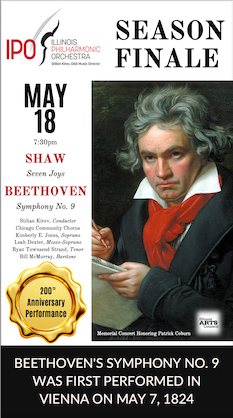Illinois Philharmonic makes impressive downtown debut with belated Zemlinsky premiere

Every so often we attend concerts that remind us that our diet of Western classical repertoire represents only a pebble in the mountain of music penned by notable composers. It may be just as well that much of it gathers dust in distant archives, but occasionally one hears a convincing performance of a worthy but neglected work that leads to questions about the wisdom of posterity.
Case in point is the music of Alexander Zemlinsky, a Viennese composer from the dawn of the 20th century who found himself at the center of cataclysmic changes that would alter the course of musical discourse for decades to come. Given his historical bona fides, it is remarkable that his twice-recorded Symphony No. 1 had never been heard in the U.S. before a splendid concert Saturday night at the Harris Theater with the Illinois Philharmonic Orchestra under the baton of music director David Danzmayr.
The composer’s mature music never flipped the switch to serialism, but his overripe expressionism inhabited a sound world not unlike the early music of Schoenberg and Berg. Zemlinsky equipped Schoenberg with his only formal training in composition but, like his compatriots and rough contemporaries Strauss and Mahler, he never quite abandoned the tonal ship.
A modest revival of his works began a quarter century ago, and while this resurgence has been more pervasive in Europe than stateside, several major American orchestras have recently performed Die Seejungfrau (“The Mermaid”) and the Lyric Symphony, while James Conlon led a rare performance of A Florentine Tragedy with the Chicago Symphony Orchestra at Ravinia in 2007.
There is nary a hint of the looming apocalypse in his Symphony No. 1 in D minor from 1892, a work that fits comfortably in the Schubert/Brahms/Bruckner lineage that was the lingua franca of Zemlinsky’s youth. He doesn’t tamper with the textbook orchestration of mid-19th century Romanticism, and he toes the line of formal classical constraints, with the novel exception of a brief up-tempo incursion midway though the slow third movement. For all its discretion there is an unmistakable allure of innocence in the youthful work, and his sturdy craftsmanship provides a workable framework for his substantial melodic gifts.
If Schubert, Bruckner and Dvorak are the main inspirations in the first three movements, Brahms is the clear model in the finale, an attribute that no doubt spurred a friendly encounter between the two composers and a much needed career boost for the young Zemlinsky.
Danzmayr’s reading wisely avoided overinflated bombast. He coaxed a burnished, fluid reading that seemed more akin to the temperate Viennese serenade than the sprawling and grandiose Brucknerian ideal. In this respect he was assisted by an orchestra of moderate size and the acoustics of a hall that—despite its visually chilly modernism—lends an appealing, cushy warmth to massed strings.
Balances were nicely regulated, excepting a somewhat recessed woodwind section, an asymmetry more likely acoustical than a deliberate strategy of the conductor. The charming scherzo might have gained from crisper articulations, and the otherwise ingratiating trio seemed a bit sluggish.
Aside from these caveats it was hard to find fault with Danzmayr’s committed and idiomatic reading, hardly surprising given his early musical training at the University Mozarteum in Salzburg. While certainly not an unqualified masterpiece, it clearly deserves an occasional hearing in our canon-obsessed concert halls. Will James Conlon’s interest in this undervalued composer ever induce a belated CSO performance at Ravinia?
Meanwhile another musical revolution was stirring on the other side of the pond, and American jazz soon imposed itself on multiple fronts. Gunter Schuller’s so-called “Third Stream” in the 1950’s made a case yet again for a fruitful coexistence of the two traditions. While his Concerto for String Quartet and Orchestra from 1988 exhibits no obvious connection to his earlier experiments in jazz/classical fusion, the nearly continuous flow of inventiveness brings to mind the linear stream of musical ideas in the improvisation of the best jazz masters. The orchestra teamed up with the superb Avalon String Quartet in the first local performance of this fascinating if imperfect work.
Schuller’s early stint as a horn player in the Metropolitan Opera Orchestra and his decades of conducting and teaching inform his resourceful command of the orchestra and unerring instincts for formal clarity. The concerto indulges in occasional whiffs of Ravel and Stravinsky, but the language is predominantly original and inventive.
As committed as Danzmayr and the young foursome were to the thorny score, the work was only intermittently compelling. It worked best when Schuller stuck to an idea for more than just a few bars, as in the propulsive and dazzling middle movement Vivace. Elsewhere, intriguing motifs vanished just as the brain was gaining an earhold, most notably in an otherwise gripping finale that was marred by a maddeningly premature conclusion.
Apart from a tentative opening bar, Danzmayer’s reading of Ralph Vaughan Williams’ Fantasia on a Theme by Thomas Tallis was delicate and well executed.
Earnest kudos and congratulations to the IPO for an intriguing program for their first downtown concert. Let’s hope they make the short journey from the south suburbs more often.
Posted in Performances






Posted Apr 27, 2014 at 4:16 pm by marilynn tannebaum
It was an amazing concert—full of beauty and energy. The condctor was dynamic and the musicians performed at a high level.